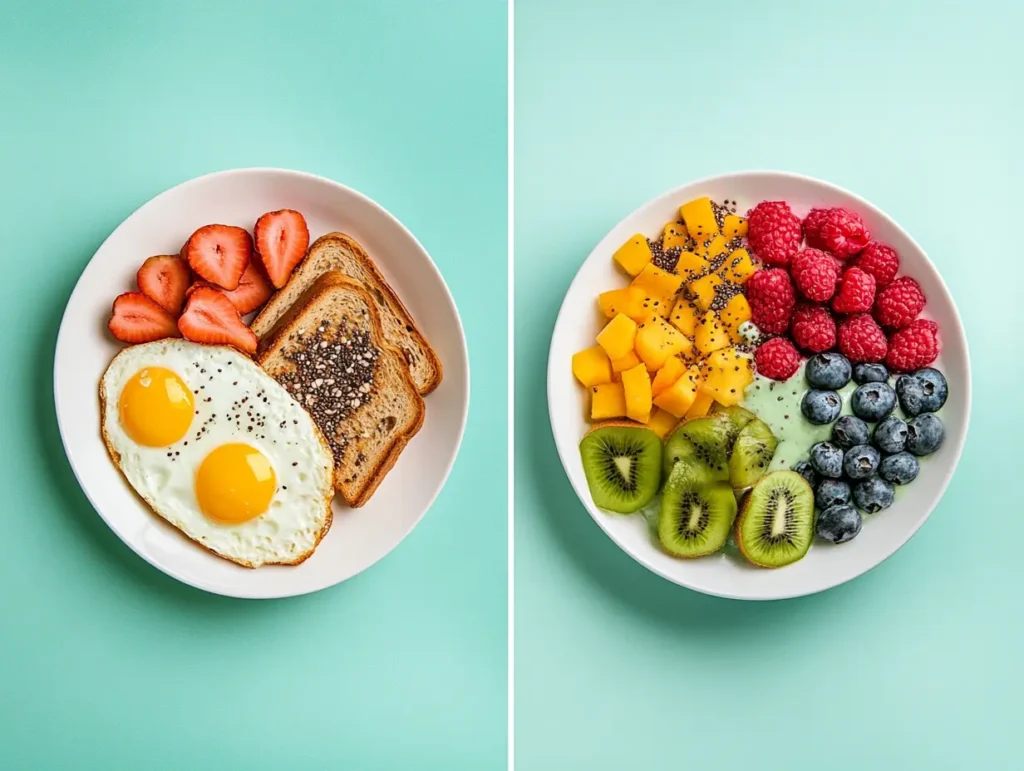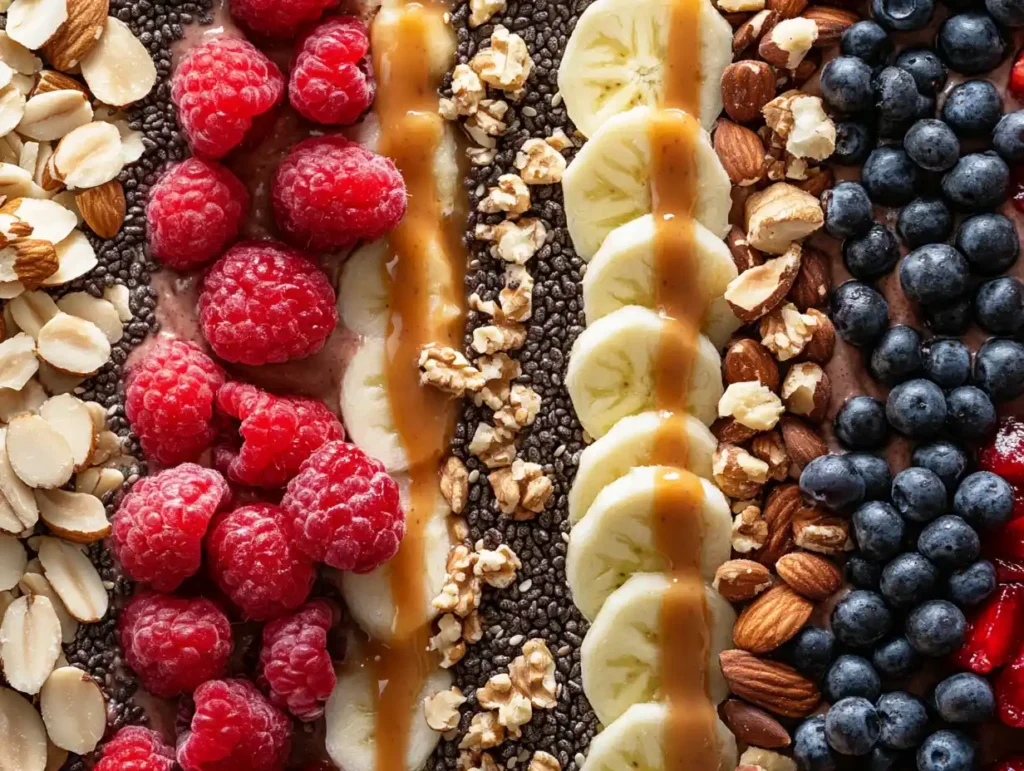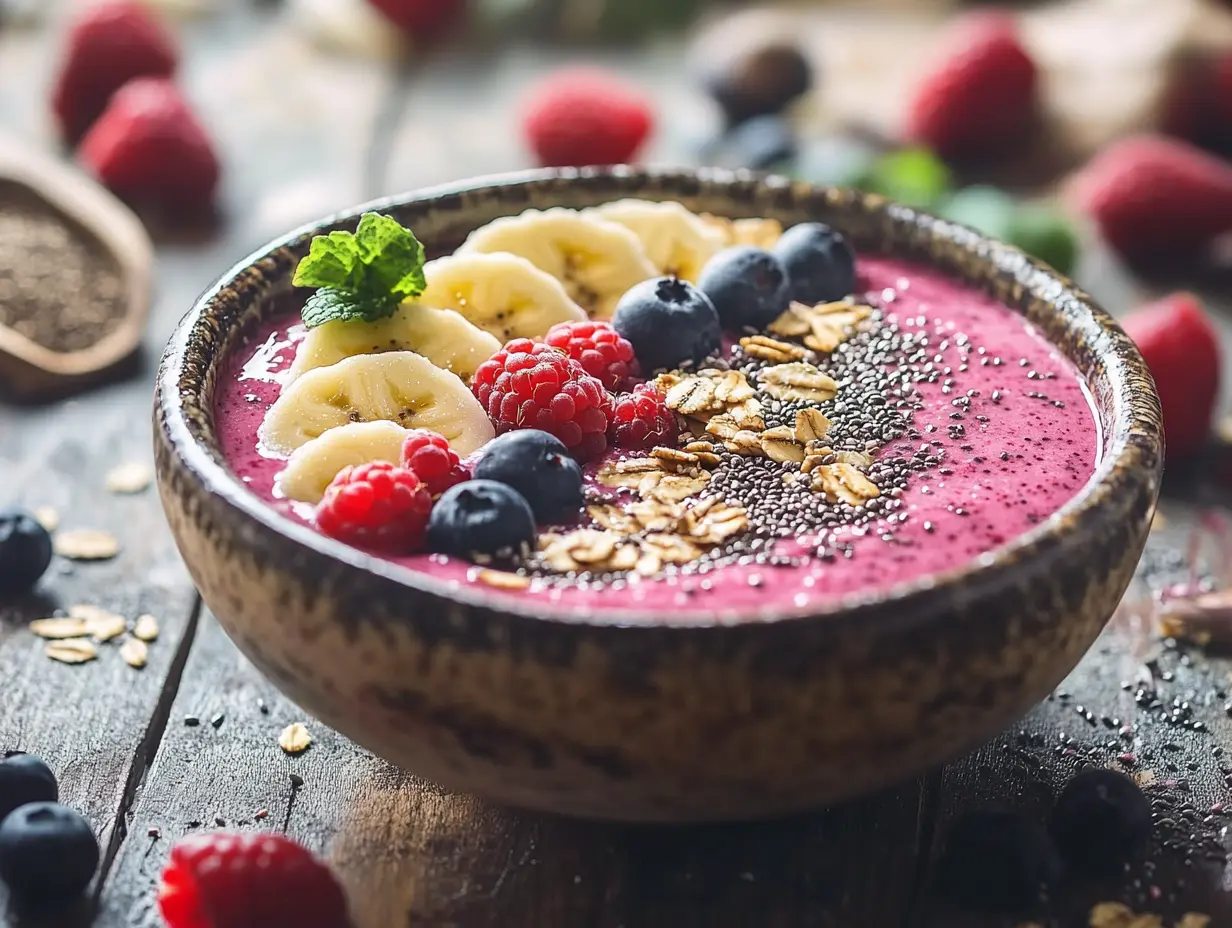Table of contents
Are Smoothie Bowls Healthy?
Smoothie bowls have surged in popularity, often touted as a vibrant and nutritious meal option. But are smoothie bowls healthy? The answer largely depends on the ingredients you choose and how they’re prepared. They can be an excellent source of vitamins, minerals, and antioxidants, but they can also pack in hidden sugars and calories if you’re not careful.
Understanding Smoothie Bowls
Smoothie bowls are thicker than regular smoothies, served in a bowl, and topped with ingredients like fresh fruit, nuts, seeds, and granola. They’re not just a feast for the eyes with their colorful presentation; they’re also a potential nutritional powerhouse. But as the saying goes, not everything that glitters is gold. While smoothie bowls can be incredibly healthy, certain pitfalls lurk beneath their delicious surfaces.
What Makes Smoothie Bowls Stand Out?
Unlike a drinkable smoothie, smoothie bowls are eaten with a spoon, giving a more satisfying experience. The base usually includes nutrient-rich options like frozen fruits, yogurt, and plant-based milks. The toppings can provide fiber, protein, and healthy fats, making the dish well-rounded and filling.
Nutritional Components of Smoothie Bowls
To truly understand whether smoothie bowls are healthy, it’s crucial to dissect their nutritional makeup. The components of a smoothie bowl determine its health benefits, so let’s break it down.
Carbohydrates in Smoothie Bowls
Most smoothie bowls derive their carbs from fruits and toppings like granola or oats. While fruits are a natural source of sugar, they also provide essential fiber, vitamins, and minerals. However, adding sugary syrups or sweetened granola can significantly spike the sugar content.
Protein Content
Smoothie bowls can be a great source of protein if you include ingredients like Greek yogurt, protein powders, or nut butters. Adequate protein is vital for maintaining muscle mass and feeling full longer.
Healthy Fats
Fats from toppings like chia seeds, flaxseeds, and nut butters not only provide energy but also help absorb fat-soluble vitamins. However, overloading on these toppings can push the calorie count higher than intended.
Health Benefits of Smoothie Bowls
Smoothie bowls, when thoughtfully crafted, can offer a host of health benefits. Packed with essential nutrients and customizable to meet specific dietary needs, they provide a refreshing and energizing start to the day. Let’s dive into the key reasons smoothie bowls are healthy for many.
Rich in Vitamins and Minerals
Fruits like berries, bananas, and mangoes in smoothie bowls are brimming with vitamins like C, A, and K, as well as minerals like potassium and magnesium. These nutrients support everything from immune function to maintaining healthy bones and muscles.
- Example Ingredients:
- Blueberries: High in vitamin C and antioxidants.
- Bananas: Rich in potassium, which helps regulate blood pressure.
High in Fiber
Fiber is a standout nutrient in smoothie bowls, particularly when you include toppings like oats, chia seeds, or flaxseeds. Fiber aids digestion, promotes satiety, and helps stabilize blood sugar levels.
- Pro Tip: Use whole fruits instead of fruit juices in your base to maximize fiber content.
Antioxidant Properties
Antioxidants combat free radicals in the body, reducing inflammation and potentially lowering the risk of chronic diseases. Many popular smoothie bowl ingredients, such as acai berries and dark leafy greens, are antioxidant-rich.
- Acai Bowls: Acai berries are loaded with anthocyanins, which are known for their anti-inflammatory effects.
- External Link: Learn more about the health benefits of acai berries.
Potential for Weight Management
Smoothie bowls can be a helpful ally in weight management, especially when portion sizes and ingredient choices are controlled. High-fiber and high-protein bowls keep you fuller for longer, reducing the temptation to snack on less nutritious options later in the day.
Potential Drawbacks of Smoothie Bowls
While smoothie bowls are healthy in many ways, it’s important to be mindful of potential pitfalls. Poor ingredient choices or portion sizes can turn a nutritious bowl into a calorie bomb or a sugar-laden dish. Let’s examine some common drawbacks.
High Sugar Content
Fruits naturally contain sugar, and that’s perfectly fine in moderation. However, smoothie bowls often include additional sweeteners like honey, agave syrup, or sugary granolas. These extras can dramatically increase the sugar content, potentially leading to blood sugar spikes.
- How to Avoid It: Choose natural, unsweetened toppings and limit added sugars. For example, opt for plain Greek yogurt over flavored varieties, which can contain hidden sugars.
Caloric Density
A common misconception about smoothie bowls is that they’re always a low-calorie meal option. In reality, calorie counts can skyrocket with too many calorie-dense toppings like nut butters, coconut flakes, and seeds.
- What to Watch For: Stick to measured portions of calorie-heavy ingredients. For instance, a tablespoon of almond butter adds about 100 calories, so use sparingly.
Nutrient Imbalance
While smoothie bowls often boast abundant vitamins and antioxidants, they can lack balance if not properly constructed. For example, a bowl loaded with fruit but lacking protein or healthy fats might leave you feeling hungry shortly after eating.
- The Fix: Aim for a balance of macronutrients by incorporating protein-rich options like chia seeds, tofu, or unsweetened protein powder alongside your fruits and greens.
Optimizing the Healthiness of Smoothie Bowls
To ensure smoothie bowls are healthy and balanced, a few simple adjustments can make a big difference. By choosing wholesome ingredients and creating a well-rounded bowl, you can maximize the nutritional benefits while avoiding common pitfalls.
Choosing Low-Sugar Ingredients
Reducing the sugar content in your smoothie bowl is a game-changer for health-conscious eaters. Stick to naturally low-sugar fruits like berries, and skip sugary additives.
- Low-Sugar Fruits to Try:
- Strawberries
- Raspberries
- Kiwi
For sweetness, consider using a small amount of a natural sweetener like stevia or simply let the fruits provide all the sweetness you need.
Incorporating Protein Sources
Adding protein is a smart way to make your smoothie bowl more satisfying. Protein helps repair tissues, supports muscle growth, and keeps hunger at bay.
- High-Protein Additions:
- Plain Greek yogurt
- Protein powders (unsweetened or plant-based)
- Nuts and seeds (e.g., pumpkin seeds, chia seeds)
Balancing Macronutrients
A truly healthy smoothie bowl should have the right ratio of macronutrients: carbohydrates, protein, and fats. This balance provides steady energy without causing sugar crashes.
- Tips for Balance:
- Include a handful of greens like spinach or kale for added fiber and nutrients.
- Add a source of healthy fats, such as avocado or flaxseeds.
- Measure portions to keep calories in check, especially for calorie-dense ingredients.
Comparing Smoothie Bowls to Traditional Breakfasts

When debating whether smoothie bowls are healthy compared to traditional breakfast options, it’s essential to consider nutritional value, satiety, and energy levels. Let’s break it down.
Nutritional Comparison
Smoothie bowls often pack a higher concentration of fruits, vegetables, and superfoods than many conventional breakfasts like toast or cereal. They provide essential vitamins, antioxidants, and fiber that processed breakfast items might lack. However, traditional breakfasts like eggs and whole-grain toast may offer more protein, which is crucial for muscle repair and sustained energy.
- Key Differences:
- Smoothie Bowls: High in vitamins, antioxidants, and natural sugars from fruits.
- Traditional Breakfasts: Often higher in protein and sometimes lower in sugar, depending on the choices.
Satiety and Energy Levels
The feeling of fullness after a meal depends on the macronutrient composition. Smoothie bowls are light and refreshing but might not always keep you full for hours unless they contain adequate protein and healthy fats.
- Energy-Sustaining Ingredients: Adding toppings like nuts, seeds, or oats can increase satiety and provide longer-lasting energy.
- Traditional Breakfast Benefits: Items like eggs or oatmeal may offer sustained energy due to their protein and complex carbohydrate content.
Which One Wins?
There’s no one-size-fits-all answer! The best option depends on your dietary goals and preferences. A smoothie bowl is a fantastic choice for a nutrient-dense, lighter meal, while a protein-rich traditional breakfast might better suit those needing sustained energy.
Popular Smoothie Bowl Ingredients and Their Health Impacts

The ingredients you choose determine whether smoothie bowls are healthy and balanced. Let’s examine some common additions and how they contribute to overall health.
Acai Berries
Known for their deep purple hue and rich flavor, acai berries are a superfood staple in smoothie bowls. They are packed with antioxidants, particularly anthocyanins, which help reduce inflammation and combat oxidative stress.
- Health Benefits:
- Supports heart health.
- Boosts immune system function.
- May aid in brain health.
Chia Seeds
Tiny but mighty, chia seeds are a powerhouse of fiber, omega-3 fatty acids, and protein. They are ideal for enhancing the nutritional profile of any smoothie bowl.
- Why Add Them:
- Improves digestion with high fiber content.
- Promotes heart health due to omega-3s.
- Provides a plant-based protein source.
- Pro Tip: Soak chia seeds in almond milk or water before adding them to your bowl for a pudding-like texture.
Nut Butters
Almond, peanut, or cashew butter not only add creaminess and flavor to smoothie bowls but also deliver healthy fats and protein. However, moderation is key due to their calorie density.
- Health Highlights:
- Healthy fats support brain function.
- Protein helps repair and build muscle.
- Rich in vitamin E and magnesium.
Nutritional Content (Per 100g of a Typical Smoothie Bowl)
| Nutrient | Amount |
|---|---|
| Calories | 150–250 kcal |
| Protein | 5–8 g |
| Carbohydrates | 20–30 g |
| Fiber | 5–7 g |
| Sugar (Natural) | 10–15 g |
| Fat | 6–10 g |
| Vitamins (C, A) | Varies |
| Antioxidants | High |
Expert Opinions on Smoothie Bowls
Nutritionists and dietitians often weigh in on the debate of whether smoothie bowls are healthy. While the consensus leans toward their benefits, experts emphasize the importance of mindful ingredient choices and portion control. Here’s what they have to say.
The Good News from Nutritionists
Experts agree that smoothie bowls can be a fantastic way to incorporate more fruits, vegetables, and superfoods into your diet. According to dietitian Samantha Cassetty, “The vibrant colors in smoothie bowls often signify a variety of phytonutrients, which are essential for overall health.” These phytonutrients support everything from immunity to skin health.
- Common Expert Advice:
- Prioritize whole, natural ingredients.
- Avoid overloading on calorie-dense toppings.
- Ensure the bowl has a balance of carbohydrates, protein, and fats.
Cautionary Notes from Experts
While smoothie bowls are undeniably nutrient-packed, some dietitians warn against excessive portion sizes. Registered dietitian Bonnie Taub-Dix explains, “Many smoothie bowls have as much sugar and calories as a dessert. It’s essential to control portions, especially with high-calorie ingredients like nut butters and sweeteners.”
- Expert Tips to Keep It Healthy:
- Stick to a single serving of toppings like nuts and seeds.
- Limit added sweeteners, including honey and flavored syrups.
- Opt for unsweetened bases like plain yogurt or almond milk.
FAQs about Are Smoothie Bowls Healthy?
Many people have questions about smoothie bowls, especially when it comes to their health benefits and potential drawbacks. Here’s a breakdown of common queries to clear up any confusion.
What are the main health benefits of smoothie bowls?
Smoothie bowls offer a rich source of vitamins, minerals, and antioxidants. With whole fruits, leafy greens, and healthy toppings, they support immunity, digestion, and overall energy levels. Adding protein sources like yogurt or seeds enhances their benefits by providing satiety and muscle-repairing nutrients.
Can smoothie bowls aid in weight loss?
Yes, smoothie bowls can be part of a weight-loss plan when carefully prepared. Their high fiber and protein content can help control appetite and reduce overeating. However, keeping portion sizes and calorie-dense ingredients like nut butter in check is essential to avoid excess calories.
Are there any risks associated with consuming smoothie bowls daily?
Smoothie bowls can become unhealthy if they’re high in added sugars or lack balance in macronutrients. Consuming them daily without varying your diet could also lead to nutrient gaps. Moderation and diversity in ingredients are key to avoiding these risks.
How can I reduce the sugar content in my smoothie bowl?
To lower sugar content:
- Use low-sugar fruits like berries.
- Skip sugary toppings like sweetened granola or syrups.
- Replace sweetened yogurt with plain or unsweetened varieties.
- Use spices like cinnamon or vanilla for natural sweetness.
What are the best protein sources to add to a smoothie bowl?
Great protein additions include:
- Plain Greek yogurt
- Chia seeds or flaxseeds
- Plant-based protein powders
- Nuts like almonds or walnuts
- Nut butters in moderation
How do smoothie bowls compare to drinking smoothies?
While both are nutritious, smoothie bowls typically contain more fiber and toppings, making them more filling. Drinking smoothies might be more convenient, but bowls often include nutrient-rich extras like seeds and granola, which can boost satiety.
Conclusion : Are Smoothie Bowls Healthy?
Smoothie bowls are a delightful and versatile option for anyone looking to enjoy a nutrient-packed meal. With their vibrant colors, delicious flavors, and ability to be customized, they can suit a wide range of dietary preferences and health goals. However, to ensure smoothie bowls are healthy, it’s vital to be mindful of the ingredients you use and the portion sizes you serve.
Balanced smoothie bowls, featuring a mix of fruits, vegetables, protein sources, and healthy fats, can offer long-lasting energy and essential nutrients. Avoiding added sugars and calorie-heavy toppings helps keep your bowl as wholesome as possible.
Whether you’re aiming for weight management, boosting energy levels, or simply adding variety to your meals, smoothie bowls can be a fantastic choice when prepared with care. So, grab a spoon and dig into a healthful, delicious, and eye-catching bowl of goodness!
